
Recently, the “clean-girl” trend has surfaced on social media. It’s characterized by glass skin, pink pilates, and Stanley water bottles. From bright multicolored water bottles to ones with names engraved on them, a Stanley Cup is a staple in every American’s cupboard. It’s a symbol of status, and community, as well as a flashy accessory. With discerning marketing, Stanley has built a $750 million water bottle empire. The trend has reached such heights that dozens of Americans are featured on the morning news grappling for not just one, but multiple cups at Target.
Stanley’s success largely relies on their marketing strategy. Scrolling through social media, you may come across countless videos featuring Stanley enthusiasts displaying their extensive collections or battling others in the store for the last bottle. The exclusivity the bottle harnesses fuels consumer desire, often leading to overconsumption. Limited-edition releases and collaborations with influencers create a sense of scarcity, making each Stanley Cup feel like a coveted item. This drives consumers to seek out and purchase multiple of these bottles.
This may take you back to the previously trending Owalla, Hydroflask, or S’well bottles, which were also heavily marketed as an eco-friendly way to stay hydrated. However, amidst this surge in popularity, a critical question arises amongst users: are these water bottles truly helping the environment? Or are they just another token of consumerism? With so many bottles flooding the market, it’s worth examining the real impact they hold on sustainability.
According to Rachel Ramirez, 85% of plastic bottles end up in the waste. These bottles take thousands of years to fully break down, leaving microplastics in our ecosystems. (NBC, 2024) Seemingly, reusable water bottles are the better solution. Indeed, they have a lower impact on the environment, but with microtrends, overconsumption may lead to a bigger problem in the future. Just like the largely popularized water bottle trends of the past, these large collections left unused often end up in landfills, leaving more trash for future generations to contend with. While they’re a sustainable alternative to single-use plastic bottles, their effectiveness may be undermined as a result of consumerism.
The life cycle of the bottle is a crucial factor to consider as well. In an NBC article, environmental experts confirmed that for a reusable water bottle to be sustainable, it must be used multiple times due to the energy used and pollution generated through the manufacturing process. The New York Times noted “the production of stainless steel bottles requires seven times the amount of fossil fuel, emits 14 times more greenhouse gases into the atmosphere” (Heiges, 2009). Heiges stated that “using the bottle a few times holds a much more detrimental impact on the environment than using several plastic bottles” (Heiges, 2009). Therefore, consumers must recognize the harmful effects of overconsumption on the environment, by committing to a few reusable water bottles, rather than buying an entire collection, using them consistently can contribute to a more sustainable future.
Although the Stanley is an attractive product, we as a society must question its practicality. Will the pros outweigh the cons? Or will we succumb to the temptation of popularity and overconsumption?
The views and opinions expressed are those of the authors and do not necessarily reflect nor represent the Earth Chronicles and its editorial board.




